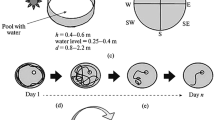Abstract
Changes in behavior of rats caused by different doses of cyclazocine (0.2, 0.4, 0.75, 1.5, and 3.0 mg/kg) were detected by two different methods: the open field and the residential maze. In the residential maze the locomotion was recorded automatically, whereas in the open field the measurements were made by direct observation. In the maze low doses of cyclazocine (<1.5 mg/kg) caused a marked change in the time course of locomotion and local activity at the beginning of the 23-h sessions. The duration of this effect was dose-dependent, between 2 and 4 h. The highest dose (3 mg/kg) induced a strong stimulation of locomotor activity which lasted about 1 h, and stereotyped patterns, i.e., long periods of unidirectional runs through circular alleys. In the open field rearing and grooming behavior proved to be the most sensitive parameters. The frequency of both was reduced at a dose of 0.4 mg/kg. Locomotion showed the highest values at 1.5 mg/kg and decreased with the highest dose (3 mg/kg) to control levels. The study demonstrated that the principal changes induced by cyclazocine were of a qualitative nature, characterized by monotonous locomotor activity. The computerized residential maze procedure proved to be well suited to detect and quantify this behavioral change.
Similar content being viewed by others
References
Alder S, Zbinden G (1983) Neurobehavioral tests in single- and repeated-dose toxicity studies in small rodents. Arch Toxicol 54:1–23
Buckett WR, Shaw JS (1975) Dopaminergic drugs antagonize the psychotomimetic effects of partial-agonist analgesics. Psychopharmacologia 42:293–297
Brimblecombe RW (1963) Effects of psychotropic drugs on open-field behaviour in rats. Psychopharmacologia 4:139–147
Broadhurst PL, Sinha SN, Singh SD (1959) The effect of stimulant and depressant drugs on a measure of emotional reactivity in the rat. J Genet Psychol 95:217–226
Elsner J, Knutti R (1981) The graphical representation of the time evolution of ECG data using a computer data storage and plot package. In: The Rat Electrocardiogram in Pharmacology and Toxicology. R Budden, D Detweiler, G Zbinden (eds) Pergamon Press, Oxford, pp 161–170
Elsner J, Looser R, Zbinden G (1979) Quantitative analysis of rat behavior patterns, in a residential maze. Neurobehav Toxicol 1:163–174
Elsner J, Wehrli R (1978) Interface systems in behavioral research. Behavior Research Methods and Instrumentation 10:259–263
Gavend MM, Serre F, Gavend MR, Ragouey C, Caron P (1981) Effects of acute administration of cyclazocine on metabolism of biogenic amines in different regions of rat brain. Psychopharmacology 75:79–83
Hall CS (1934) Emotional behavior in the rat. I. Defecation and urination as measures of individual differences in emotionality and ambulatory behavior. J Comp Psychol 22:254–263
Hearzen CA (1970) Subjective effects of narcotic antagonists cyclazocine and nalorphine on the addiction. Psychopharmacologia 18:366–377
Holzman SG, Jewett RF (1973) Stimulation of behavior in the rat by cyclazocine: Effects of naloxone. J Pharmacol Exp Ther 187:380–390
Irwin S (1968) Comprehensive observational assessment: A systematic, quantitative procedure for assessing the behavioral and physiologic state of the mouse. Psychopharmacologia 13:151–158
Martin WR, Fraser HF, Gorodetzky CW, Rosenberg DF (1965) Studies of the dependence-producing potential of the narcotic antagonist 2-cyclopropylmethyl-2′-hydroxy-5,9-dimethyl-6,7-benzomorphan (cyclazocine, WIN-20,740, ARC II-C-3). J Pharmacol Exp Ther 150:426–436
Schneider C (1968) Behavioral effect of some morphine antagonists and hallucinogens in the rat. Nature 220:586–587
Author information
Authors and Affiliations
Additional information
This work was supported in part by the Swiss National Science Foundation and the Bundesministerium fuer Jugend, Familie und Gesundheit, FRG
Rights and permissions
About this article
Cite this article
Looser, R., Elsner, J. & Zbinden, G. Behavioral effects of cyclazocine on rats assessed in the open field and residential maze. Psychopharmacology 84, 323–330 (1984). https://doi.org/10.1007/BF00555207
Received:
Accepted:
Issue Date:
DOI: https://doi.org/10.1007/BF00555207




